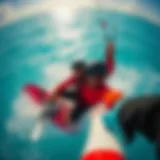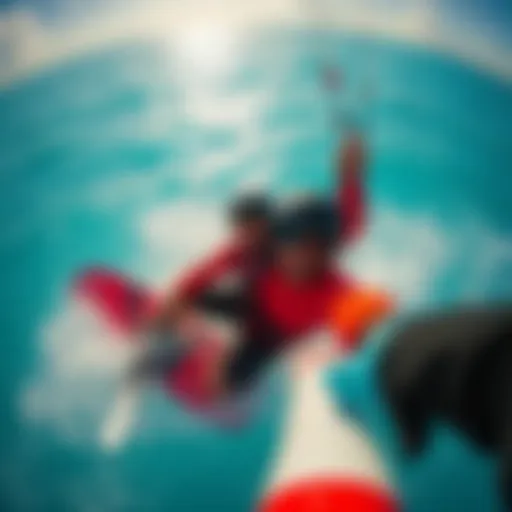Discover Kitesurfing Camps Across the Caribbean


Intro
The Caribbean, a shimmering paradise known for its azure waters and white-sand beaches, is also the playground for kitesurfing enthusiasts from around the globe. This wind-powered sport combines the thrill of surfing with the aerial buzz of kite flying, attracting both rookies and veterans alike. With a plethora of kitesurfing camps nestled across the islands, one might wonder what sets these locations apart. By shedding light on their characteristics, facilities, instruction quality, and the unique local culture, adventurers can find their perfect kitesurfing haven.
In this article, we will navigate through various aspects vital to planning your kitesurfing adventure. We’ll dive into the essential gear needed for every kiteboarder, unravel advanced techniques for those looking to elevate their skills, and provide insights into safety practices to keep your experience exhilarating yet secure. Additionally, we will discuss the cultural treasures of the Caribbean islands that enrich the overall kitesurfing experience, making each trip not only about the sport but also about the incredible surrounding environments.
All in all, this will serve as a comprehensive guide designed to equip you with the knowledge necessary for selecting the best kitesurfing camps while embracing the vibrant life of the Caribbean.
Preamble to Kitesurfing Camps
Kitesurfing camps hold a special place in the heart of water sports, merging adventure with community spirit. For many kiteboarding enthusiasts, these camps represent more than just a place to learn—they are gateways to exhilarating experiences in some of the world’s most picturesque locales. In this article, we explore the nuances of kitesurfing camps in the Caribbean, a region renowned for its stunning coastlines and ideal wind conditions.
The significance of kitesurfing camps is multifaceted. They cater not only to beginners aiming to catch their first gust of wind but also to seasoned riders eager to refine their skills and connect with like-minded adventurers. When you choose a kitesurfing camp, you’re selecting a structured environment where professional instructors guide you, providing safety and expertise. This assures a level of confidence that is often hard to achieve independently, especially for those who are new to the sport.
Defining Kitesurfing Camps
To put it simply, kitesurfing camps are dedicated facilities that focus on teaching and improving kitesurfing skills. These camps vary in offerings, from intensive week-long courses to casual weekend getaways. They often cover a range of skill levels, ensuring that whether you’re a novice or an experienced rider, there’s a place for you. Not only do camps provide lessons, but they also typically include equipment rental, accommodations, and additional activities, creating a holistic experience.
The instructors at these camps are usually well-trained and possess a wealth of knowledge about local conditions. They help tailor the learning experience through personalized feedback, ensuring that each participant can progress at their own pace. The goal is not just teaching but cultivating a safe and enjoyable riding experience while fostering a love for the sport.
The Allure of the Caribbean
The Caribbean has an undeniable charm, captivating anyone fortunate enough to visit. Its stunning beaches, vibrant culture, and crystal-clear waters provide the perfect backdrop for an array of water sports, especially kitesurfing. With islands like the Dominican Republic, Jamaica, and Cuba, each offering unique conditions, the allure is not merely about the sport but also about the environment it unfolds in.
Wind conditions are typically favorable year-round, making many Caribbean islands prime spots for kitesurfing. Imagine gliding over turquoise waters while gentle breezes lift you effortlessly into the air—a feeling that’s both thrilling and liberating. Furthermore, the sense of community found within these camps adds a social aspect that many travelers seek.
"The Caribbean isn’t just a destination; it’s an experience that leaves you with stories worth telling."
The cultural richness of the Caribbean also enhances the adventure. Many camps offer excursions that dive into the local traditions, culinary delights, and vibrant festivals. Engaging in these cultural experiences can deepen your connection to the islands and provide memories that extend beyond the water.
In summary, the introduction to kitesurfing camps reveals their pivotal role in shaping the experiences of kiteboarding enthusiasts. By combining skill development with a vibrant community atmosphere and stunning natural beauty, kitesurfing camps in the Caribbean promise an engaging adventure for all.
Choosing the Right Kitesurfing Camp
Selecting the perfect kitesurfing camp is akin to picking a fine wine; the right choice can elevate your experience and enrich your time on the water. With numerous schools and facilities scattered throughout the Caribbean, making a well-informed decision becomes paramount. Different camps cater to varying skill levels, preferences, and amenities, which means there’s something for everyone—from the greenhorn eager to catch their first wave to the seasoned rider looking to refine their tricks. The journey to find a fitting camp involves considering skill level, facilities, instructor qualifications, and, importantly, the community vibe.
Assessing Skill Levels
When venturing into kitesurfing, understanding where you fit along the skill spectrum can streamline your search for an appropriate camp.
Beginner Camps
Beginner camps are vital stepping stones in the kitesurfing world. Catering specifically to novices, they typically offer a well-structured environment where newbies can learn the ropes without feeling overwhelmed. The key characteristic of these camps lies in their tailored instruction and supportive settings.
- Unique Feature: Many beginner camps utilize comprehensive beginner kits, ensuring equipment is manageable for less experienced riders.
- Advantages: The environment is usually more relaxed, allowing beginners to gain confidence. Furthermore, the social aspect fosters friendships as everyone starts on similar footing. However, a disadvantage might be limited wind conditions, impacting how often one can get in the water.
Intermediate Camps
For those who’ve mastered the basics, intermediate camps offer a more challenging setting without stepping too far out of one’s comfort zone. These camps strike a balance, usually concentrating on skill enhancement while introducing maneuvers like jumps and turns.
- Unique Feature: Personalized coaching sessions at many of these centers, combined with progression-focused group activities, encourage rapid skill advancement.
- Advantages: One major benefit is that riders can practice with those at their same level, which fosters a sense of camaraderie. But, a downside is that you might find the intensity a bit daunting if you feel stuck without progression.
Advanced Camps
Advanced camps cater to seasoned kite surfers seeking to hone their skills or learn advanced tricks. The focus here is on refinement rather than basics, often involving techniques that enhance aerial maneuvers and speed control.
- Unique Feature: The presence of professional coaches and access to premium equipment typifies advanced camps, ensuring top-notch training.
- Advantages: Riders are oftentimes pushed to explore new frontiers in their kitesurfing journey. However, these camps can feel competitive, which may not suit everyone’s taste in a learning environment.
Facility Options and Amenities
The kind of facilities and amenities available at kitesurfing camps plays a significant role in determining overall comfort and satisfaction.
Accommodation Types
Accommodation options can sail from basic hostel-style rooms to luxurious seaside villas. The ability to choose a suitable accommodation can significantly affect one’s overall experience.
- Unique Feature: Many camps offer on-site lodgings, providing convenience as well as easy access to the beach.
- Advantages: Staying at the camp can promote bonding among campers and instructors, while sharing experiences after a day on the water. However, more luxurious options may come with a hefty price tag, potentially making them less accessible for some.
On-Site Equipment Rental
Having the option to rent equipment on-site offers immense convenience. This feature can ease the burden of traveling with gear, which is often cumbersome and costly.
- Unique Feature: On-site rentals usually include the latest gear, ensuring you can kite with high-quality equipment.
- Advantages: No more hassle of lugging gear through airports. On the flip side, if you are particular about your gear, on-site options might not match what you're accustomed to.
Dining Options
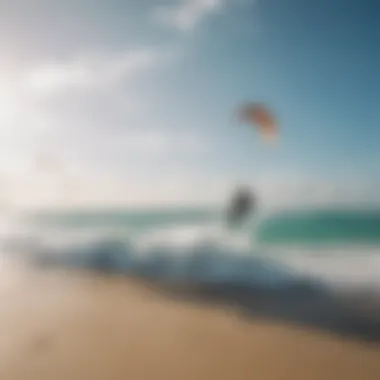

After a long day of riding, dining options at the camp become increasingly important. Camps that provide diverse and healthy meals will enhance your experience on and off the water.
- Unique Feature: Some camps emphasize nutrition designed for athletes, tailoring meals to the specific energy needs of kiteboarders.
- Advantages: Having meals on-site means convenient fueling for your adventures. However, limited culinary options might disappoint some, making it worthwhile to check menus ahead of time.
Instructor Qualifications
The quality and credibility of instructors can make or break the kitesurfing experience. Potential campers should be vigilant in assessing these qualifications.
Certifications to Look For
Not all certifications hold equal weight. It�’s essential to look for instructors certified by recognized organizations, which ensures you’re learning from individuals who meet industry standards.
- Unique Feature: Many camps display their instructors’ certifications prominently, building trust with potential clients.
- Advantages: Ensured safety and quality of learning. A downside is that sometimes, passionate local instructors with great insight might lack formal credentials but still offer incredible learning opportunities.
Experience Levels
The experience level of the instructors is equally crucial, as seasoned instructors are better equipped to address a range of students’ needs.
- Unique Feature: Experienced instructors often bring unique techniques or styles from their own kitesurfing journey, which can be enriching.
- Advantages: You’ll gain from their real-world tips and tricks, enhancing your skill set. However, highly experienced instructors may cater primarily to advanced riders, sometimes leaving to the side beginners needing a bit more guidance.
Top Destinations for Kitesurfing Camps
When diving into the realm of kitesurfing camps, the selection of your destination plays a crucial role. The Caribbean offers a diverse range of locations that not only serve up predictable winds and mesmerizing waters but also foster a vibrant kitesurfing community. Each island boasts unique characteristics, catering to different skill levels and preferences. Whether you're a rookie or a seasoned kiteboarder, the right camp can enhance your experience, transforming it into a memorable adventure.
The Dominica Republic
Ideal Locations
The Dominican Republic stands out as a kitesurfing hotspot, particularly in areas like Cabarete and Punta Cana. These locations are famous among kiteboarders for their consistent trade winds and favorable water conditions. Cabarete, for instance, is known for its warm turquoise waters and winds that range from gentle to strong, depending on the season. This balance makes it particularly appealing to kitesurfers looking to sharpen their skills.
The beaches here are not just beautiful; they create a playground for both beginners and experts alike. Newbies can practice in the protected waters, while experienced riders can venture into the open ocean for a bit of a thrill. Additionally, the local culture enriches the atmosphere, making it more than just a sport; it becomes a full-fledged experience.
Local Camp Recommendations
When considering local camps in the Dominican Republic, places like Kite Beach Hotel and Cabarete Kiteboarding School continually pop up as popular choices. These camps provide a variety of options, from accommodations that overlook the ocean to tailored instruction from seasoned pros. It’s worth noting that many of these camps foster a welcoming environment, encouraging camaraderie among participants.
The benefit of these local camps lies in their immersion within the community; they often host events and workshops that not only enhance kiting skills but create lasting bonds among kiteboarders. However, it's essential to check reviews and possibly connect with past attendees to find a camp that aligns with your personal style and expectations.
Cuba's Unmatched Conditions
Best Spots for Kitesurfing
Cuba presents a different vibe altogether. Here, you'll find places like Varadero and Cayo Guillermo, which are blessed with long stretches of white sandy beaches and remarkably steady winds. The conditions are particularly appealing for those looking to enjoy kitesurfing without overcrowded spaces.
What's special about these spots is that they often attract a mix of locals and international kiteboarders, resulting in a relaxed yet vibrant atmosphere. In Varadero, the wind typically blows consistently during the winter months, making it a prime spot.
Notable Camps
In terms of notable camps, one standout is the Kite Club Cuba, located on Cayo Guillermo. They provide top-tier equipment rentals and have instructors who are known for their friendly and knowledgeable approach. This camp not only focuses on skill improvement but also emphasizes the importance of safety and understanding local conditions. The unique feature here is the cultural aspect, where you can enjoy local cuisine and music, enriching the overall kitesurfing experience.
Beautiful Jamaica
Camps and Community
Jamaica's charm extends into the kitesurfing arena, particularly in Spots like Treasure Beach or Long Bay. The community vibe is prevalent, offering a sense of belonging whether you are a visitor or a local. Camps here are known for their strong emphasis on inclusivity — it becomes more about enjoying the journey together rather than just kitesurfing.
The camps often cater to a diverse range of skill levels, cultivating an environment of learning and shared experiences. Many attendees establish friendships, and take part in organized events that span beyond just kiting.
Kiting Conditions
The kiting conditions in Jamaica can be a bit more variable compared to other Caribbean destinations, but when the winds align, the experience is unparalleled. Generally, the best time for kiting is during the winter months, when trade winds are at their peak. However, when conditions are not favorable for kiting, other activities, like enjoying the beach or local excursions, are plentiful.
Turks and Caicos
Serene Environments
In Turks and Caicos, the tranquil atmosphere is a breath of fresh air. With shallow waters and endless sandy flats, this destination is ideal for those looking to relax while kiting. The gracefulness of the scenery really compliments the thrill of kitesurfing, creating a full-body experience.
Many kiteboarders appreciate these serene environments for focusing solely on their skills while enjoying the pristine surroundings. Each kitesurfing camp often offers a blend of relaxation and adventure, allowing a moment to soak in the beauty of the islands.
Camp Highlights
Among the highlights, the Turks and Caicos Kiteboarding Camp stands out. It emphasizes personalized instruction and small group settings, which can significantly enhance the learning experience. They offer various packages, including those tailored for families or artists seeking inspiration from the ocean.
However, it’s vital to book in advance as these camps can fill up quickly, especially during peak seasons. A unique aspect is their commitment to sustainable practices, promoting environmental awareness while also providing unforgettable kitesurfing experiences.
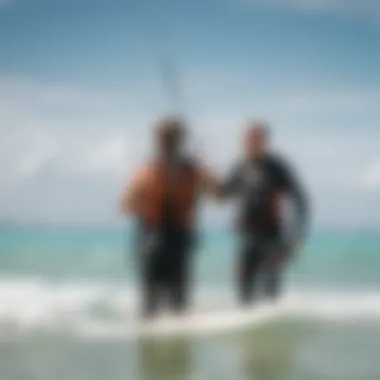

Overall, these top destinations in the Caribbean showcase not just the sport of kitesurfing, but also the rich culture and community surrounding it. The agreements in location, community spirit, and camp quality all contribute to an unforgettable experience.
"In kitesurfing, the location may lure you in, but the community keeps you coming back."
Understanding the Seasonality of Kitesurfing
Diving into the seasonal aspects of kitesurfing reveals a fascinating interplay between nature's cycles and the thrilling sport itself. As the weather and wind patterns change throughout the year, they dictate not only when the best conditions for kitesurfing occur but also how these aspects influence the experiences at various camps. Knowing the ins and outs of seasonality is crucial for enthusiasts, as it empowers them to maximize their adventures and safety.
Best Time to Kitesurf in the Caribbean
The prime seasons for kitesurfing in the Caribbean typically fall between November and June, when consistent trade winds grace the islands. Those who plan their trips during these months often find themselves with favorable wind conditions and optimal weather. Generally, January through March mark the peak, as breezes tend to be steady, making it ideal for both newbies and seasoned riders.
Weather and Wind Conditions
Seasonal Variations
Seasonal variations play a critical role in shaping the overall kitesurfing experience. The Caribbean is known for its fairly consistent wind patterns, but subtle shifts can make a big difference. In the dry season, the wind tends to be stronger and more reliable, providing a smooth ride for kitesurfers of all skill levels. It’s almost like clockwork; as the summer rolls around, the winds can be light, which is less favorable for high-speed kitesurfing. Those willing to brave the heat may still enjoy quieter, less crowded waters during this time.
- Key characteristics of seasonal variations include:
- Consistency in Wind: Stronger winds during the dry months make for better kitesurfing conditions.
- Temperature Variability: Warm waters invite longer sessions but can become muggy in summer.
Ultimately, understanding these patterns allows riders to choose their timing wisely, ensuring they hit the water when conditions favor them.
Impact on Riding Safety
Safety is paramount in kitesurfing, and the weather plays a huge role. Wind conditions directly affect riding safety and comfort. On windy days, it’s easy to lose control without proper experience. Those gentle breezes might seem tempting, but they can lead to unpredictable conditions, especially if a storm is brewing nearby. Local weather forecasts become your best friend in planning safe outings.
- The impact on riding safety is influenced by:
- Predictability of Conditions: Knowledge of seasonal wind patterns and weather forecasts can prevent mishaps.
- Awareness of Local Changes: Kitesurfers must remain vigilant about sudden weather changes that can arise out of nowhere.
By keeping these considerations in mind, riders can equip themselves for safe and enjoyable sessions on the water.
Cultural Events and Festivals
Celebrations Around Kitesurfing
The Caribbean isn’t just about stunning beaches and wind conditions; it’s also a tapestry of culture that enhances the kitesurfing experience. Numerous festivals and events celebrate not just kitesurfing, but also the community it creates. Local competitions often occur, gathering enthusiasts of all levels to partake in friendly rivalry and camaraderie. These events can be fantastic opportunities to learn from seasoned riders and immerse oneself in the vibrant culture of the islands.
- Unique features of celebrations include:
- Community Gatherings: Festivals help forge connections among kitesurfers.
- Skill Development Opportunities: Many events include workshops or tutorials with professionals.
Such experiences deepen one’s understanding of both the sport and the local culture, enriching the kitesurfing journey.
Best Times to Visit
Timing your visit not only affects your sport but can also enhance your experience with cultural events. Generally, aligning your trip with festivals gives you the chance to explore the culture while enjoying kitesurfing at its best. Popular events often occur during the peak kitesurfing season, ensuring that adventure and festivities go hand-in-hand.
- Key aspects of the best times to visit include:
- Synchronization with Events: Visiting during a kitesurfing festival can provide unique experiences.
- Maximized Adventure: Combining sport with local culture creates unforgettable memories.
Planning around these periods offers a dual reward for visitors, allowing them to relish both the thrill of the waves and the richness of Caribbean traditions.
"By understanding the nuances of seasonality, every kitesurfing enthusiast can transform their trip into an extraordinary adventure, tailored to their skill level and cultural interests."
Whether you're a novice looking to jump on a board for the first time, or a seasoned pro hunting down the perfect wave, being mindful of the seasonal variations and cultural happenings can significantly enhance your experience.
Safety Considerations While Kitesurfing
Kitesurfing in the Caribbean, while thrilling, does come with its share of risks. Having a solid grasp of safety considerations is crucial not just for an enjoyable experience but also for ensuring your well-being on the water. From essential gear to environmental awareness and adhering to proper safety procedures, these elements provide a structured approach to kitesurfing. Understanding these factors helps kiteboarders of all skill levels mitigate risks and make informed decisions while pursuing this exhilarating sport.
Essential Safety Gear
Helmet
One cannot overstate the necessity of a good helmet when kitesurfing. This piece of equipment acts as your first line of defense against potential head injuries. Many kiteboarders favor helmets that offer durability and comfort. A notable choice is the Pro-Tec Full Cut Helmet, known for its excellent fit and lightweight design. This helmet stands out due to its soft padding that absorbs impact without weighing you down. While it provides substantial protection, it’s worth noting that some users might feel a bit restricted in their head movements when wearing it. Nevertheless, the peace of mind that comes with knowing your head is protected makes it invaluable.
Impact Vest
An impact vest is another must-have when hitting the waters. While it primarily serves to cushion your body against hard landings, it also provides buoyancy, which can be a lifesaver in rough conditions. The Mystic Star Impact Vest is a popular choice for many kitesurfers because it combines flexibility with sufficient protection. Its unique feature is the built-in flotation that enhances safety without compromising mobility. However, these vests can sometimes feel a bit bulky, affecting comfort levels. Still, the added layer of protection it affords makes it a worthwhile addition to any kitesurfer’s gear.
Harness
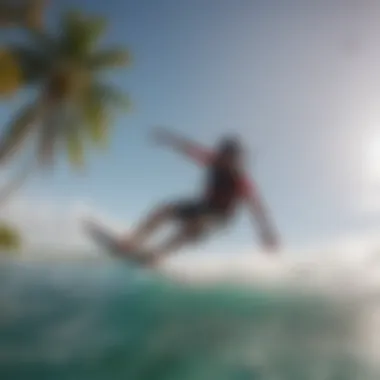

Selecting the right harness sets the stage for a better kitesurfing experience. The harness connects you to the kite by spreading the pull across your body. Here, the Naish Hook Style Harness comes highly recommended because of its ergonomic design that ensures a snug fit. Its unique feature is the quick-release mechanism that boosts safety by allowing an easy detach when needed. However, some users report that it takes a bit of getting used to as it may shift during intense sessions. Overall, a harness enhances control and comfort, making your time on the water much more enjoyable.
Environmental Awareness
Water and Weather Conditions
Understanding water and weather conditions is vital for safe kitesurfing. Knowledge of how tides, currents, and wind patterns behave in different areas can make or break your day on the water. For instance, shallow waters can often bring unexpected challenges, especially if the weather changes suddenly. The key characteristic of assessing water conditions is recognizing that what looks calm can transform drastically in a matter of minutes, particularly when the wind picks up. Kiteboarders should always check local weather forecasts and be aware of seasonal shifts to better gauge their safety on the water.
Local Wildlife Considerations
While kitesurfing, being aware of local wildlife is another critical safety component. Many parts of the Caribbean are home to both beautiful and potentially harmful creatures. For example, jellyfish can pose threats with their stings, and certain areas may have manatee zones where you need to be extra cautious. Understanding local wildlife doesn't just enhance your safety; it also enriches your experience, letting you respect these creatures in their home. Maintaining distance and always being alert to your surroundings ensures a smooth and safe day of kitesurfing.
Standard Safety Procedures
Buddy System
Safety in numbers is never more true than in kitesurfing. Implementing a buddy system is essential, especially for less experienced riders. Having a partner not only provides a safety net but also enhances the experience as you share the thrill. This system allows you to help each other in case of gear failure or unexpected accidents. The buddy system is beneficial because it creates a more controlled environment, ensuring that there’s someone to lend a hand when needed. However, it requires both partners to communicate effectively and stay aware of each other's movements.
Emergency Contacts
Establishing a clear emergency contact plan can save lives. Having a list of local emergency services and knowing who to call in different situations is of utmost importance. Consider making use of waterproof pouches to carry essential contact numbers while out on the water. Such preparations enhance your safety significantly, giving you immediate access to help if things go south. Still, relying on technology such as mobile phones in remote areas can sometimes be futile due to connectivity issues. Therefore, also carry physical copies of your emergency contacts, ensuring that you’re covered in various situations.
Safety in kitesurfing is not just about gear; it’s about awareness, preparation, and the camaraderie that comes from sharing the experience.
The Community Aspect of Kitesurfing Camps
Kitesurfing camps offer more than just thrilling experiences on the water; they bring together a community of enthusiasts. While honing one’s skills is important, the companionship developed at these camps adds another layer of enjoyment. After all, kitesurfing isn’t merely about the wind and waves; it’s about the shared journey among fellow adventurers, each person contributing to the overall atmosphere.
Social Dynamics Among Campers
Building Connections
One of the most significant aspects of kitesurfing camps is the opportunity for building connections. Campers come from various backgrounds, yet they all share the same passion for kitesurfing. This common interest serves as an icebreaker, allowing individuals to form friendships quickly. These connections often extend beyond the camp itself, fostering a network of like-minded kiteboarders.
A notable characteristic of these bonds is their informal nature. People find it easy to chat with others while waiting for the perfect wind conditions or sharing a meal after a long day of riding. Unlike many other sporting environments, where the culture may feel competitive, kitesurfing camps promote camaraderie.
The unique feature of building connections at these camps is that it creates a support system for riders. Campers often help each other with tips, encouragement, or even gear. However, newcomers or those shy about engaging in energetic social settings might find it challenging to connect.
Shared Experiences
Shared experiences play a fundamental role in the community aspect of kitesurfing camps. The experience of riding the same waves or facing similar challenges fosters a sense of unity. Whether it's the first time a camper successfully lands a trick or the moment they witness a breathtaking sunset after a long day in the water, these moments become cherished memories.
This aspect of shared experiences is crucial for building a strong bond among attendees. Participants often recount their adventures around a campfire or during evening get-togethers, reinforcing camaraderie.
However, while many embrace these shared moments, not everyone may feel comfortable opening up. Some might prefer to keep their experiences private, which can create a gap in mutual understanding. Still, those who engage actively often find it rewarding, emerging with lasting friendships and memories.
Encouragement and Collaboration
Skill Sharing
Skill sharing is another vital element of kitesurfing camps, enhancing the overall experience. As diverse skill levels converge at these camps, novice and experienced kiteboarders can converse, demonstrating techniques or providing helpful feedback. This exchange of skills often accelerates one's learning process.
A defining trait of skill sharing is how it brings everyone together; no matter one's level, there’s always something new to learn. More experienced boarders have much to offer in terms of technique or style, while newcomers bring fresh perspectives that spur creativity.
However, it can be easy to inadvertently create a hierarchy. Experienced riders might overshadow less proficient ones, making them feel intimidated. A supportive environment counteracts this, ensuring that everyone feels included in the learning process.
Group Activities
Engaging in group activities is equally essential to the community atmosphere. From organized kite sessions to beach barbecues and team competitions, these activities solidify bonds among campers. The spirit of collective engagement often leads to fun and laughter, which are essential for breaking the ice and fostering interactions.
One special feature of group activities is their ability to build teamwork. Whether it's a playful relay race on the water or a collaborative effort to plan a group excursion, these experiences elevate the sense of community.
Nevertheless, the nature of group activities can present varying degrees of comfort. Some participants may inherently shy away from large gatherings, preferring small group settings. Recognizing this diversity is important, as accommodating both types of individuals ensures that all campers find a niche where they feel comfortable and included.
The fusion of skill sharing, group activities, and social dynamics creates a rich tapestry of experience at kitesurfing camps. It nurtures not only personal development in the sport but also fosters friendships and community bonds that can last long after the winds have died down.
Closure
As we wrap up our exploration of kitesurfing camps in the Caribbean, it's worth reflecting on what makes this adventure so captivating. The combination of stunning scenery, wind conditions, and a vibrant community defines the kitesurfing experience and elevates it beyond mere sport. Whether you are a novice setting out on your journey or a seasoned pro seeking new thrills, these camps offer a unique environment that nurtures growth and encourages bonds between participants.
Reflecting on the Kitesurfing Experience
The experience of kitesurfing itself is transformative. Feelings of exhilaration wash over you with each gust of wind as you master the art of maneuvering across the water. In the Caribbean, the turquoise waters create a playground that is both beautiful and challenging. At camps, you don’t just learn to ride; you become part of a global community that shares the same passion for adventure and freedom. It’s not simply a sport, but a way to connect with both nature and fellow enthusiasts. This camaraderie is particularly vibrant in places like Cabarete in the Dominican Republic, where the thrill of kitesurfing is often complemented by the lively social scene.
"In every wave crashed and every gust felt, memories are woven into the fabric of the kitesurfing journey."
Looking Ahead to Future Adventures
As you contemplate your future in kitesurfing, the possibilities seem endless. The Caribbean is just the tip of the iceberg. New camps are emerging, and destinations worldwide are becoming increasingly accessible. Each visit not only hones your skills but also presents opportunities to discover local cultures and connect with other kiteboarders.
- Explore lesser-known spots like Nevis or the Grenadines for a more intimate and unique experience.
- Look for specialized camps that cater to niche interests, be it freestyle, wave riding, or even yoga combined with kitesurfing.
- Take off the board and immerse yourself in the local cuisine or join non-kiting activities that camps often offer, creating a more holistic experience.




